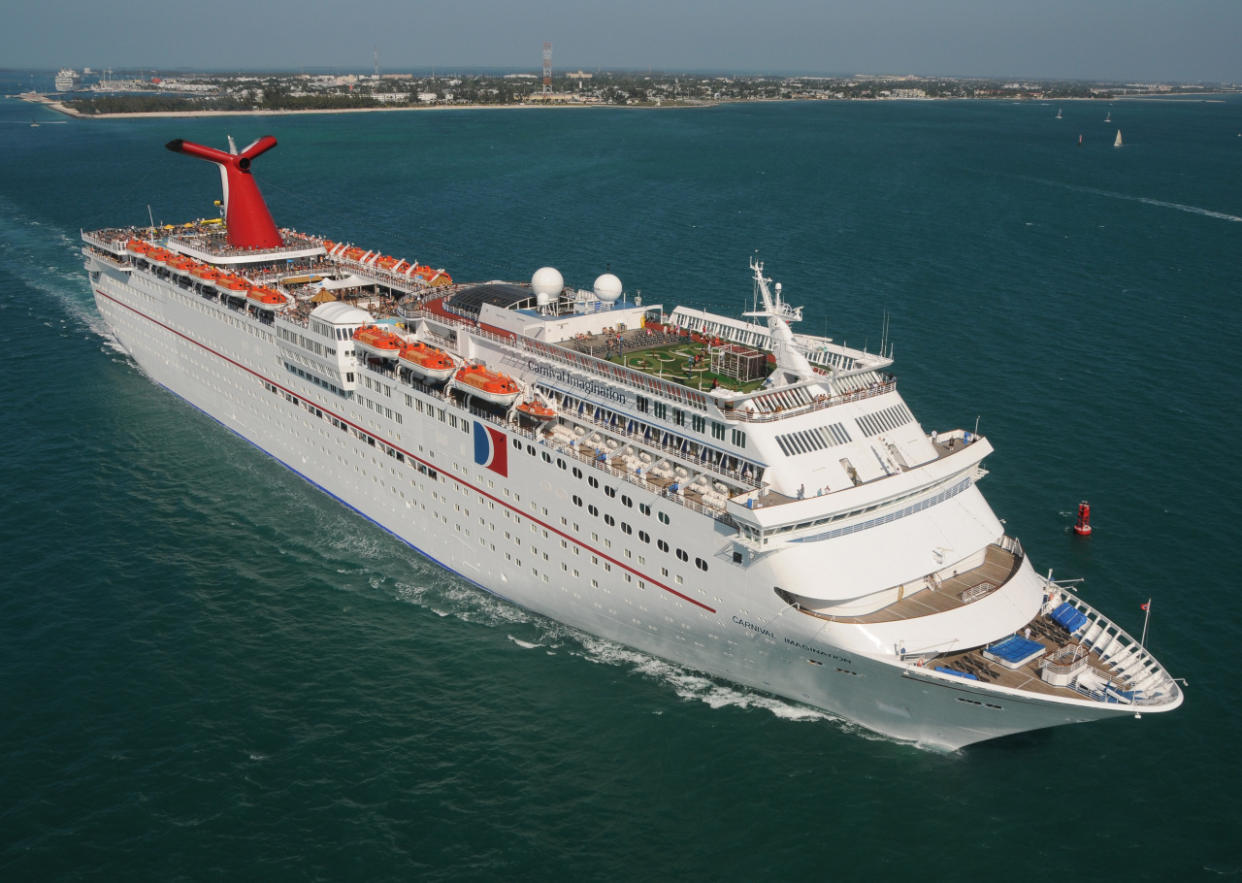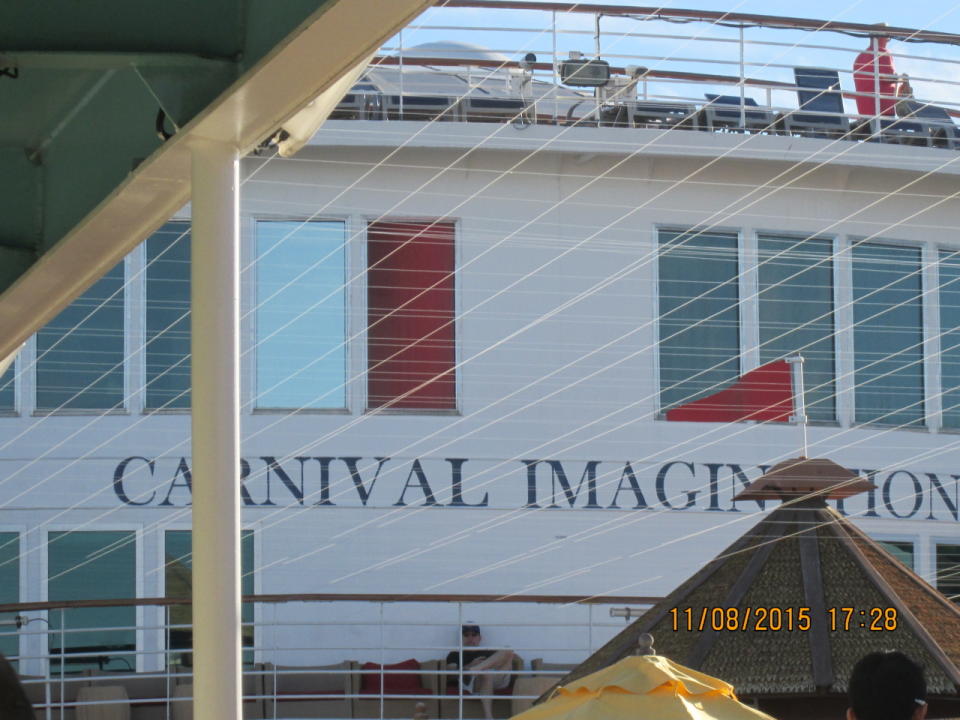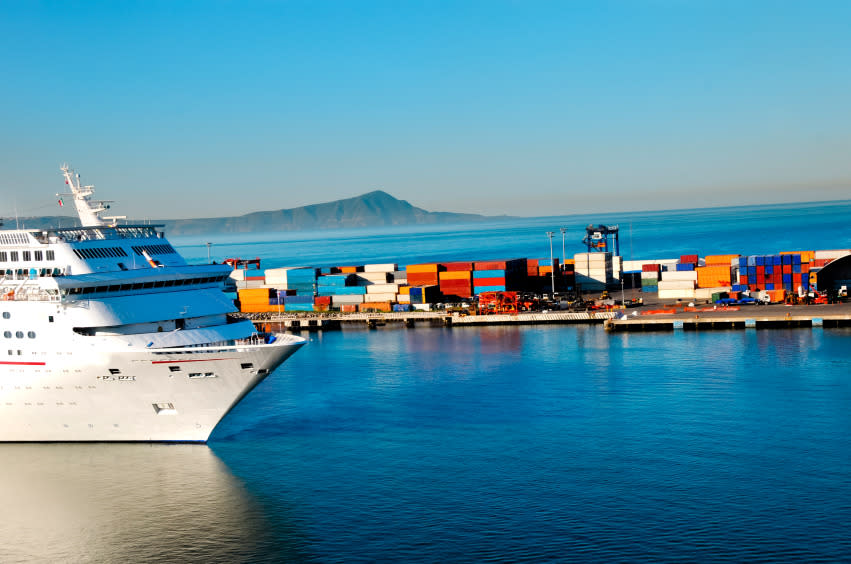Can You Get Kicked Off a Cruise For Getting Hurt? This Woman Says It Happened to Her

A passenger aboard the Carnival Imagination had a shorter-than-expected vacation. (Photo: Carnival)
It probably comes as no surprise that you can get kicked off a cruise for being rowdy or doing something illegal. But you may not know that you can be forced to leave a cruise — in a foreign port, against your will — for getting injured.
That’s what happened to Mary Rosenberg of Penn Valley, Calif. Rosenberg says she and her travel companion, a friend from church, were asked to leave the Carnival Imagination just two days into their four-day cruise after Rosenberg suffered a fall. Rosenberg says the two were left helpless in Mexico, charged $1,800 to get back to the United States, and told they would have to eat the fare they’d paid for the unused portion of her cruise.
Now, Rosenberg is angry, Carnival is admitting someone screwed up, and we’re getting another lesson in the perils of getting hurt during an international trip.
“It was so irresponsible for Carnival to treat us that way,” says Rosenberg. "I’m just appalled at the treatment I got after I got injured on their cruise.“
Related: Stranded in Mexico With a Deathly Ill Kid: One Mom’s Travel Nightmare
A cruise cut short
Rosenberg says she and her friend had spent a year planning their Mexican vacation in celebration of her friend’s birthday. On November 8, they drove from their home in northern California down to Long Beach to board the Carnival Imagination for the four-day cruise to Ensenada, Mexico.
The evening of the second day at sea, Rosenberg accidentally fell on board the ship. "I was coming out of the elevator and my shoe either stuck on the carpet or I got it caught in my long pants,” Rosenberg recalls. “I fell face forward. I landed primarily on my right side because my right arm got totally mangled.”

Mary’s photo of the Imagination before her soon-to-be-abbreviated trip began. (Photo: Mary Rosenberg)
She says crew members wheeled her to the infirmary, where medical personnel performed X-rays and gave her painkillers. They then gave her a bit of shocking news, but not about her injury.
“They said, ‘We cannot have you on board with this liability. We are going to leave you in Ensenada,’” Rosenberg recalls. “I went, 'No, you’re not. I paid for this cabin. It’s fully paid for until Thursday. It’s only 48 hours until we get back to Long Beach to my car.’” Rosenberg says she even offered to spend the rest of her trip in her cabin, a junior suite with a balcony. “It wasn’t exactly an inside cabin that I would have been claustrophobic in,” she says.
But her protests fell on deaf ears. “They said, 'I’m sorry, we can’t have you on board the ship injured like this,’” Rosenberg recalls, adding that her travel partner was told she’d have to get off in Ensenada as well.
“They wheeled me back to my room and said, 'We’re going to be picking you up at 8 o'clock in the morning and please be packed up and ready to leave,’” says Rosenberg. “And that was it.”
Dropped off in Mexico
Rosenberg says Carnival did just as promised, escorting her and her friend off the ship and leaving them at the dock in Ensenada. An ambulance the cruise line had arranged to take them to the U.S. border was waiting. Adding to the stress of being injured, being asked to leave the ship, and losing her cruise fare, Rosenberg says the duo was terrified to be dropped off alone in Mexico.
“If you’ve seen the news lately, it is not a safe place for anybody, much less two unaccompanied female seniors,” she says. “We were scared beyond belief.”
Related: Tourists Killed in Mexico: Is It Safe to Go Right Now?

Rosenberg says she and her travel companion were dropped off here at the port in Ensenada. (Photo: iStock)
Fortunately, the hour-plus trip north to the U.S. went without incident. The ambulance dropped them off at the border, where Rosenberg and her friend found another ambulance waiting to take them to a nearby hospital in Chula Vista, Calif., where Rosenberg’s injury was examined again.
“They said, 'Don’t worry, you’re going to be fine; just see your doctor when you get home,’” Rosenberg says. “And then they released me.” With Rosenberg’s husband also traveling and unable to assist, the duo had to take an Amtrak north to Long Beach to retrieve their car for the ride home.
Adding insult to injury (literally!), Rosenberg says the Mexican ambulance that took her to the border didn’t accept her medical insurance, so she was charged $1,800 for that ride, on top of the cost of the Amtrak trip home and the unused portion of their cruise fare — all costs for a decision she says was made against her will after she was injured.
“If they had allowed me to stay in my cabin [for the rest of the cruise], I could have read a book and sat out on the balcony — albeit in pain — and ended my cruise on a happier note than it did,” she says. “But that’s not the case. They threw my girlfriend and I off the boat in Mexico. I had no recourse.”
Yes, a cruise line can make you leave a ship if you get hurt
Rosenberg might be right about the “no recourse” part. Turns out Carnival, and most cruise lines, can remove you from a cruise if they deem it medically necessary. In Carnival’s Ticket Contract, Clause 2 (b) reads: “Carnival and the Master each reserves the right to refuse passage, disembark or confine to a stateroom any Guest whose physical or mental condition, or behavior would be considered in the sole opinion of the Captain and/or the ship’s physician to constitute a risk to the Guest’s own well-being or that of any other Guest or crew member.”
It seems they have as much power to throw you off as flight crews have to kick you off a plane these days.
Related: Passengers Keep Getting Kicked Off Planes: What If It Happens to you?
Dr. John Bradberry, who was the medical director for Carnival Cruise Line and is now an Atlanta-area physician, tells Yahoo Travel that rule is there to protect passengers.
“If a passenger has a medical condition so severe that it obviously represents an imminent threat to life or limb to the point that remaining on board is unreasonable, it is acceptable to conduct an involuntary medical disembark,” he says.
That said, Dr. Bradberry has some questions about how Carnival handled Rosenberg’s incident. “I am not willing to attempt to second guess the ship’s physician in this case,” he says, “but on the surface it appears an 'Against Medical Advice’ approach may have been a reasonable compromise.” Against Medical Advice (AMA) is a form a passenger can sign that acknowledges he or she is refusing medical advice — in this case, the ship physician’s advice that Rosenberg leave the ship and seek medical treatment shoreside — and allows the passenger to stay on board while indemnifying the ship’s crew and the cruise line from liability.
“Mentally competent people of legal age generally have the right to decline recommended medical care,” Dr. Bradberry says. “Unfortunately, a bit of medical 'hardball’ appears to have been played with the patient."
WATCH: Cruise Safety
Stay safe on your cruise! (Video: Travel Channel)
Dr. Bradberry knows from his days as a ship’s doctor that an injured cruiser eager to continue with his or her vacation often makes questionable medical decisions, including the decision to stay on the ship — a decision that could ultimately be life-threatening once the cruse ship, which likely has limited medical facilities, hits the open sea hundreds of miles away from the nearest specialist or trauma center. "If a passenger has a medical condition so severe that… remaining on board is unreasonable, and has high probability to adversely impact ships operations such as causing the ship to have to divert, it is acceptable to conduct an involuntary medical disembark,” he says.
But he doesn’t believe that process has to be adversarial. “It’s universally accepted that the doctor/patient relationship should be based on trust, cooperation, and support rather than antagonism and opposition,” Dr. Bradberry says. “The situation is no different on board a cruise ship.” He adds: “No passenger should be essentially abandoned by the cruise lines in a port of call.”
On that last point Carnival seems to agree. After Rosenberg reached out to the consumer advocate website, Elliott.org, where her story was first reported, the cruise line acknowledges an error with that $1,800 ambulance ride to Ensenada. “In a situation such as this, the guest is typically provided transport to a suitable shoreside medical facility at our expense,” Carnival spokesperson Jennifer de la Cruz tells Yahoo Travel. “There appears to have been a failure to follow established protocol in this regard. Normally the guest would have been assisted by a company team member once she left the vessel. We are addressing internally to ensure our procedures are followed in the future. We are extremely sorry to learn of Ms. Rosenberg’s experience and she is being contacted to ensure she receives an apology and is properly reimbursed.”
But as for the decision to escort Rosenberg and her travel partner off the ship, Carnival’s siding with the crew. “It is up to the shipboard medical team’s discretion as to the level of care required and what is the best course of action for the guest from a health perspective,” de La Cruz says. “Our teams are charged with acting in the best interest of our guests at all times.”
How to protect yourself
If you do get injured on a cruise or any journey, travel insurance can help reduce the hardship. Says Dr. Bradberry: “Many personal health insurance policies, including Medicare, typically do not cover U.S. citizens when traveling outside the U.S.” — as Rosenberg found out the hard way when the Mexican ambulance refused to accept her health insurance and she got stuck with an $1,800 bill. The right travel insurance plan can cover your overseas medical care as well as the cost of a medical evacuation back to your home country — expenses that could otherwise run into the tens of thousands of dollars (make sure your travel insurance plans don’t have caps that could adversely limit your coverage).
Of course, having travel insurance won’t keep you from being escorted off your cruise should you get hurt. But it could help ease the financial pain for your treatment, transportation and lost fare.
A painful ordeal continues
Now back at home, Rosenberg says the cruise line contacted her several times to check up on her. Since then, Carnival — as it said it would do in its statement to Yahoo Travel — has offered to reimburse her for the Mexican ambulance ride, plus her out-of-pocket costs for her Chula Vista hospital fee and the cost of her cabin.
Still, she remains angry and hurt — badly, it turns out. Her shoulder was injured so severely in the fall, she had to have shoulder replacement surgery. She also has nerve damage that has left her right harm mostly useless. “All of my emails and computer stuff is done with my left hand,” she says. “They don’t know if it’s permanent or temporary,” she says.
Still, Rosenberg wants to make one thing clear: she is not blaming Carnival for her injury. “I’m not pointing fingers at Carnival,” she says about her fall. “It happened so fast, I don’t know whose fault it was. It could have been my stupid fault, I don’t know. It would be irresponsible for me to blame Carnival for something I don’t really know how it happened.”
“All I’m doing is trying to make them responsible for their actions, and what they did to me as one of their paying customers,” she continues. “Would they have treated their mother or grandmother in the same fashion they treated me?”
WATCH: Cruising With Kids? You Need to Know These Tips
Let Yahoo Travel inspire you every day. Hang out with us on Facebook,Twitter, Instagram, and Pinterest. Check out our original adventure travel series, “A Broad Abroad.”

